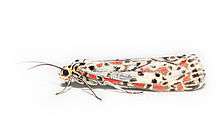Utetheisa pulchelloides
Utetheisa pulchelloides, the heliotrope moth, is a moth of the family Erebidae. It is found in the Indo-Australian region including Borneo, Hong Kong, New Zealand, Papua, Seychelles and most of Australia. The species was first described by George Hampson in 1907.
| Heliotrope moth | |
|---|---|
 | |
| Scientific classification | |
| Kingdom: | Animalia |
| Phylum: | Arthropoda |
| Class: | Insecta |
| Order: | Lepidoptera |
| Superfamily: | Noctuoidea |
| Family: | Erebidae |
| Subfamily: | Arctiinae |
| Genus: | Utetheisa |
| Species: | U. pulchelloides |
| Binomial name | |
| Utetheisa pulchelloides | |
| Synonyms | |
| |
Adults undertake extensive and frequent migratory flights and can reach the most remote oceanic islands, such as Henderson Island and Ducie Island.
Description
Hindwing of male with no fold or glandular tuft on inner margin. Head and thorax yellowish. Collar and tegula each with two black spots. Each thoracic segment with one each black spot. Third joint of palpi black and abdomen whitish. Forewing white with five interrupted scarlet bands with series of black spots between them. A marginal series of black spots present. Hindwings are semi-diaphanous white, but some specimen with black on the discocellulars. A very irregular black sub-marginal band, broad at apical area and between veins 1b and 3. Larva dark grey with a dorsal white band and sub-dorsal series of red spots. Head yellow.[2] It pupates in a loose cocoon that spun in the leaf litter on the ground below the food plant.[3]
Ecology
The larvae feed on Argusia argentea, Echium plantagineum, Heliotropium arborescens and Myosotis arvensis.[4][5][6]
Subspecies
- Utetheisa pulchelloides pulchelloides Hampson, 1907 (Chagos Islands, Seychelles, Amirantes and Cargados Carajos Islands)
- Utetheisa pulchelloides aphanis Jordan, 1939 (islands south-east of New Guinea)
- Utetheisa pulchelloides darwini Jordan, 1939 (Cocos (Keeling) Islands)
- Utetheisa pulchelloides marshallorum Rothschild, 1910 (Marshall Islands, Fiji, Samoa, Swain's Island, Tonga, Tokelau Islands, Phoenix Islands, Tuvalu, Gilbert Islands, Wake Island, Cook Islands, Line Islands, Tuamotu Archipelago, Henderson Island)
- Utetheisa pulchelloides papuana Jordan, 1939 (New Guinea)
- Utetheisa pulchelloides umata Jordan, 1939 (Guam)
- Utetheisa pulchelloides vaga Jordan, 1939 (China: Guangdong, Guanxi, Yunnan; Taiwan; Madagascar; islands of the Indian Ocean; Sri-Lanka; south-east Asia; Moluccas; Australia)
Utetheisa salomonis (including the former Utetheisa pectinata ruberrima) may also belong into this species.
Gallery

 Dorsal view
Dorsal view Ventral view
Ventral view Head
Head
References
- Dubatolov, V.V. (November 1, 2012). "Tiger Moths (Lepidoptera, Arctiidae) of the Oriental Region, Australia and Oceania". Siberian Zoological Museum. Institute of Animal Systematics and Ecology.
- Hampson, G. F. (1894). The Fauna of British India, Including Ceylon and Burma: Moths Volume II. Taylor and Francis – via Biodiversity Heritage Library.
- Herbison-Evans, Don & Crossley, Stella (14 June 2018). "Utetheisa pulchelloides Hampson, 1907 Heliotrope Moth". Australian Caterpillars and their Butterflies and Moths. Retrieved 23 January 2019.
- Don Herbison-Evans & Stella Crossley & Mike & Pat Coupar (April 27, 2008). "Utetheisa pulchelloides". linus.socs.uts.edu.au. Archived from the original on 2008-07-29. Retrieved 2008-12-11.
- Holloway, Jeremy Daniel. "Utetheisa pulchelloides Hampson". The Moths of Borneo. Retrieved 24 July 2016.
- "Utetheisa pulchelloides Hampson". Insects in Indian Agroecosystems. ICAR-National Bureau of Agricultural Insect Resources. Retrieved 24 July 2016.
| Wikimedia Commons has media related to Utetheisa pulchelloides. |